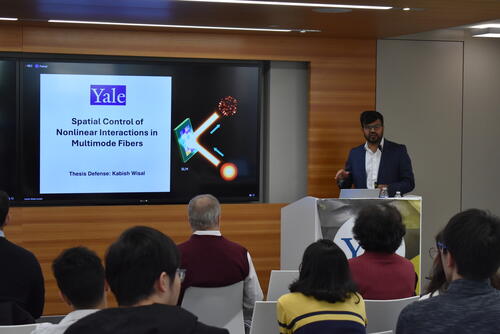
On April 8, Kabish Wisal successfully defended the thesis “Spatial Control of Nonlinear Interactions in Multimode Fibers” (advisor: A. Douglas Stone).
Wisal explained, “Shaping the wavefront of light — controlling the spatial pattern of light — has become a powerful tool for manipulating optical beams in complex environments. While wavefront shaping has traditionally focused on controlling linear scattering, my thesis explores how it can also be used to control nonlinear scattering inside multimode optical fibers. At high powers, fiber lasers suffer from nonlinear instabilities like stimulated Brillouin scattering (SBS) and transverse mode instability (TMI), which cause light to scatter backward or fluctuate unpredictably. I showed that by carefully designing the input wavefront to excite many spatial patterns (or modes) within a multimode fiber, we can suppress these instabilities and stabilize the laser output. Through a combination of new theories, simulations, and experiments, my work demonstrates a new route to scaling fiber lasers to higher powers without sacrificing beam quality — enabling advances in areas such as gravitational wave detection, precision manufacturing, and directed energy applications.”
Wisal will be joining ASML in San Jose, CA as a senior software engineer (R&D).
Thesis Abstract: In recent years, there has been significant advancement in controlling optical scattering by structuring the wavefront of the incident light, or `wavefront shaping’. Most applications of wavefront shaping have focused on linear scattering, but there is a growing interest in tailoring nonlinear scattering. In this thesis, we explore a new approach based on wavefront shaping for suppressing certain instabilities induced by nonlinear scattering in passive and active multimode fibers (MMFs). Specifically, we focus on suppressing stimulated Brillouin scattering (SBS) and transverse mode instability (TMI). A key motivation for our work is power scaling in high power fiber lasers and amplifiers, which has been primarily limited by SBS and TMI.
SBS is caused by nonlinear acousto-optic scattering, and can lead to undesirable backreflection above a certain power threshold. Whereas, TMI leads to fluctuations in the output beam profile due to nonlinear thermo-optical scattering. Previous efforts to suppress SBS and TMI have primarily utilized single mode fibers, driven by their smooth gaussian output beam profile. In contrast, we utilize wavefront shaping of coherent light to selectively excite multiple modes in an MMF, which we show allows suppression of SBS and TMI, while simultaneously controlling the output beam profile.
We develop new theories and computational models of SBS and TMI for highly multimode excitations in passive and active MMFs. Our theories predict mitigation of both SBS and TMI upon generic multimode excitations. The results for SBS suppression are confirmed experimentally in both passive and active fibers, while predictions for TMI mitigation are validated with numerical simulations. We also develop an optimization framework to find the optimal input wavefronts for maximal SBS and TMI suppression, both individually and jointly. Finally, we provide a theoretical proof for the existence of an input wavefront to obtain any given output in an MMF amplifier with dissipation and nonlinear scattering. Our work creates a new avenue for generating ultra-high laser continuous wave laser power with a narrow linewidth, enabling applications in gravitational wave detection, advanced manufacturing and directed-energy delivery.